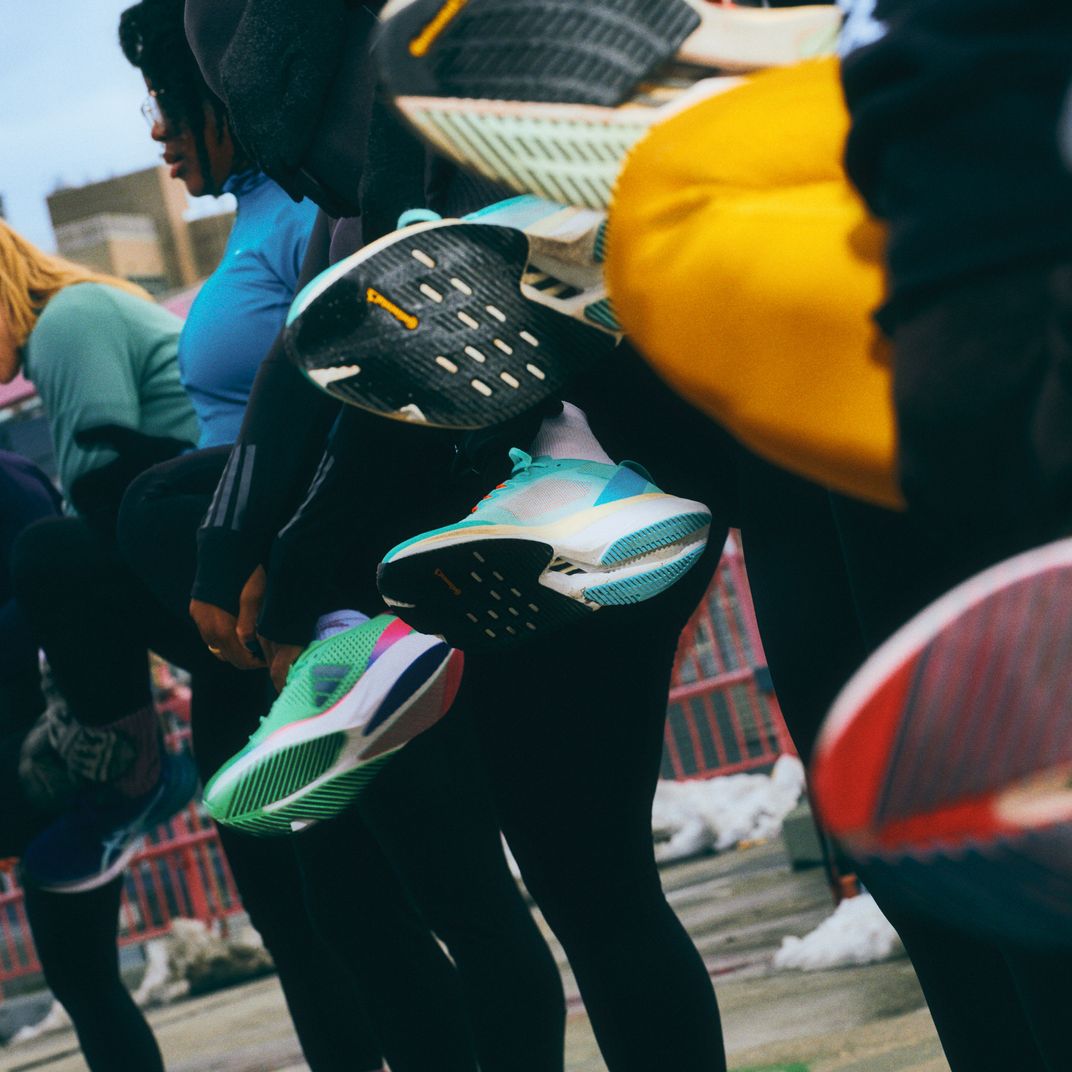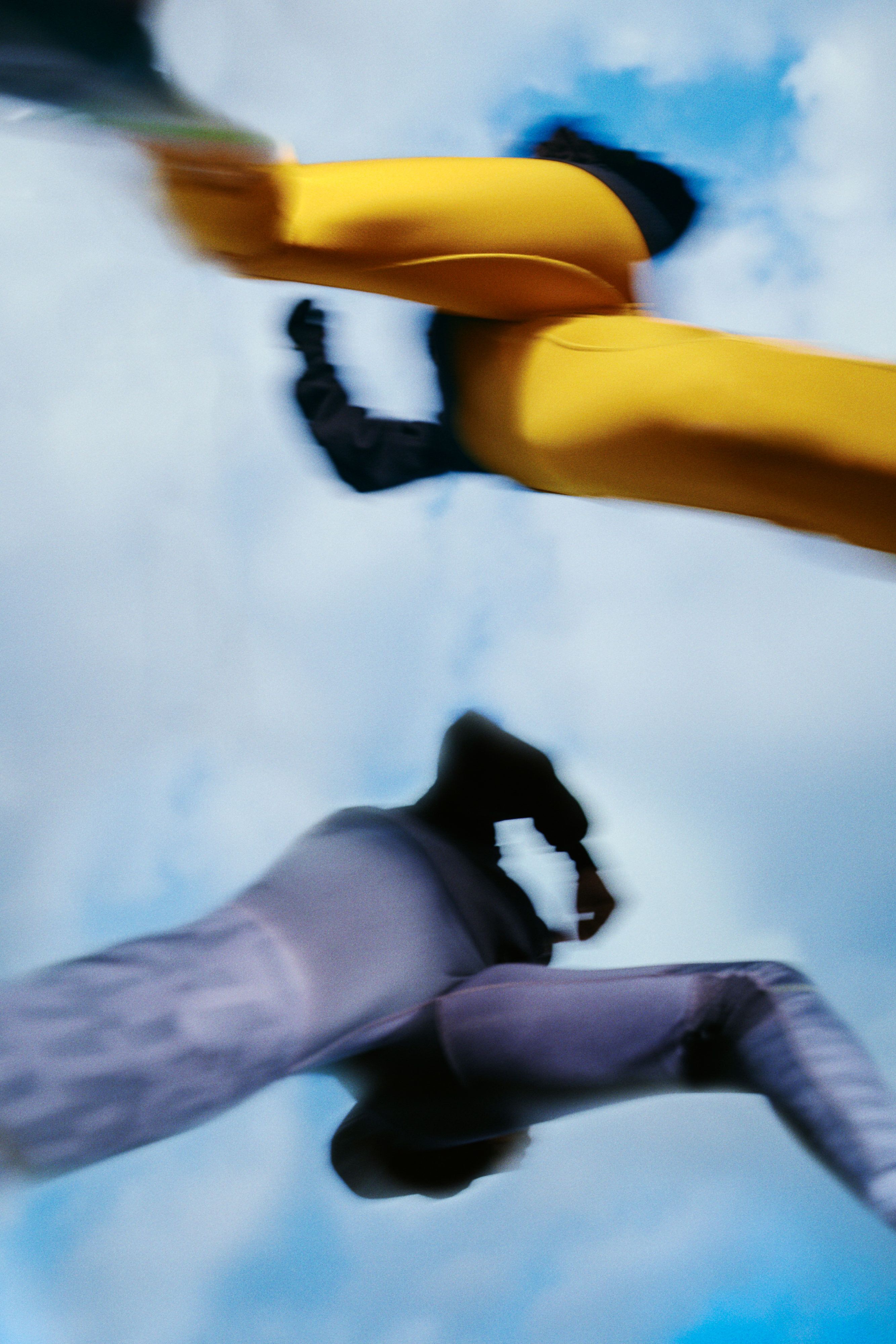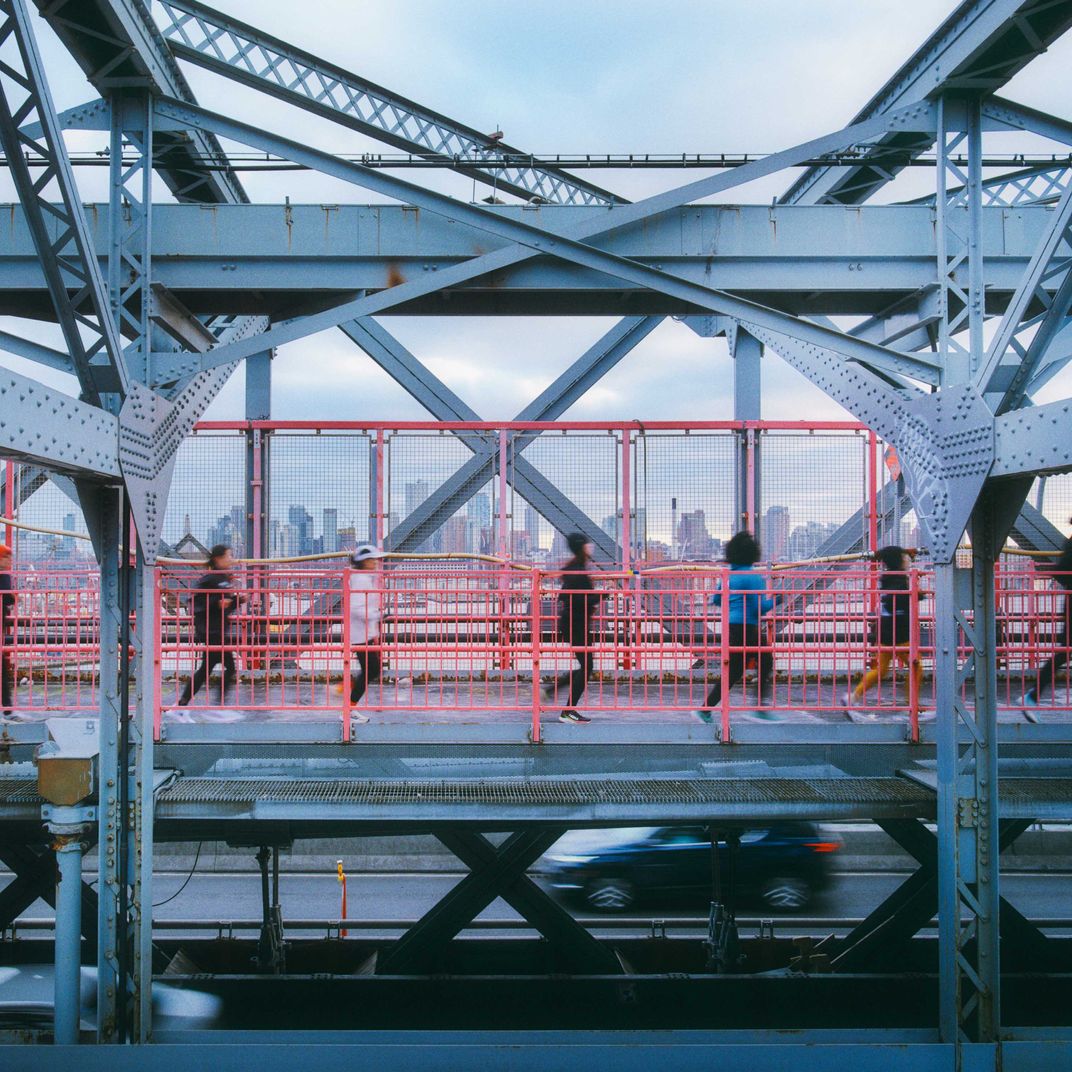
Running is often a solitary act, an unfurling of limbs propelled by fear or courage or some other fiery feeling. At first glance, it requires little beyond time, a pair of shoes (even those are not essential, pending terrain), and a body that is willing. For longer ventures or intensive sprints, running necessitates planning: rationing energy, balancing tenacity with rest. Motivational quotes about the sport tend to be paired with stock photos of sunrises and sunsets, a reminder that a running routine can be miraculous.
There are, of course, infinite reasons why a person might be hesitant to run, especially in New York City. When she launched Girls Run NYC in 2014, creative-arts psychotherapist and runner Jessie Zapo wanted to make it easier for women of all abilities to run “in fellowship with others,” whether they’re novices or professional athletes. At first, her idea was to host a “pop-up run.” Soon after, it became a weekly Wednesday-night event at McCarren Park Track, and through winter, takes place along the Williamsburg Bridge. “It was created as a meetup, just a way to bring all these women together, even if they belonged to other running clubs or communities,” says Zapo. “I had been co-leading in quite a few coed groups and saw there was this intimidation factor. A lot of women were concerned about being new, not fast enough, not looking like a runner, not knowing enough … Our goal was to create a space where it didn’t feel scary, and you weren’t going to show up and get left behind in the dust.”
Soon after founding Girls Run, Zapo completed her USA Track and Field Coaching certification. She enlisted two close friends as co-captains, Rasheda Herndon and Ameerah Omar. (“The three of us equally lead,” Zapo says.) Over the last ten years, the group has exploded beyond weekly track runs. They’ve organized trips to Iceland, Copenhagen, Berlin, Toronto, Los Angeles, and Phoenix to race half-marathons and ultramarathons and everything in between. They’ve hosted fundraisers for a local women’s shelter and the Women’s Prison Association. They’ve trained women for their first ultramarathons at Black Canyon Ultras in Arizona and beyond, and coached others to run their first mile. Midway through the Berlin Marathon, two athletes rang Herndon—who Zapo describes as “a lifeline” to many—for a pep talk. “I had my phone by my ear,” Herndon says of one conversation, even though it was the middle of the night. “I was ready for that call. I gave her a swift little kick in the butt.”
The essence of Girls Run is the Wednesday meetup, a format simple enough to be sustainable. Most of the year, the park’s track offers a contained environment. The trio — Zapo, Herndon, and Omar — show up at 6 p.m., whatever the weather. There are introductions, then a warm-up and drills, followed by an interval workout, where attendees can feel things out based on their natural pace and ability. This is framed as a “challenge by choice” — anyone is welcome to sit out — followed by a cooldown and stretching. “We don’t take membership fees,” Zapo says. “We don’t take sponsor money. It’s a space we have total ownership over, so we don’t have to do what a brand wants us to.”
There’s no official way to become a member of Girls Run — people come and go and often return after a spell away. Zapo used to monitor attendance but decided it wasn’t necessary to keep tabs on the runners in such a rigid way. Within a single year of roll call, hundreds had run with the group. “We’re often a place for women who are in their 20s and early 30s, trying to make it in the city,” says Zapo. “They’re looking for a space to have fellowship, maybe get some guidance, to feel like they belong somewhere. I think the three of us were all those women at one point — in the city at a young age, just trying to get by. I remember feeling everything was so inconsistent in New York … that the one consistent thing I had was this running group.”
Around 2016, Chiyo Yamauchi, a journalist and editor who’d arrived in New York from Tokyo, profiled Girls Run for a Japanese publication. “At the time, I was not a runner at all,” she says. “Even though they kindly asked me to join, I couldn’t picture myself running.” During the pandemic, her priorities shifted. “I was drawn to the inherent accessibility of running, a sport that one can initiate and sustain effortlessly.” She reconnected with the group and has been running with them since. “As someone who had never been naturally inclined toward social interactions and struggles with the nuances of small talk — compounded by the language barrier — I encountered initial challenges,” she says. “Despite my reserved nature, I found myself embraced.”
“When I run with people, I don’t listen to any music,” explains Yamauchi. Alone, her audio fluctuates depending on a workout’s intensity. On jogs, she turns to podcasts. To push herself, it’s dancehall, reggae, techno, and Afrobeats.
“It took me a long time to consider myself a runner,” Herndon says. “I don’t come from a background of runners. The family support is not there at all … I remember my grandma would constantly say, You did a run again today? Well, did you win? And I’d say no. Well, why do you keep running? You never win — you’re not good at it obviously. It’s hard to get people to understand you’re not running to win the race. For me, running was about winning my own race.”
Jessica LeBron, a New York middle-school teacher, marathoner, and ultramarathoner, attended Girls Run gatherings from the very beginning. “It felt special ten years ago, and it still feels special,” she says. “Girls Run NYC meets every Wednesday, period. Ten years later, I keep coming for the community, meeting new women, finding support and love.”
Although she currently lives in Brooklyn, “I began running in the Bronx,” LeBron explains. “Fun fact: It’s the greenest borough. My favorite places to run there are the New York Botanical Gardens, Bronx Park, and Pelham Parkway to City Island or Orchard Beach. I would run to these places all year round, no matter the weather. I loved to see each season morph a new visual landscape … While there’s a lot of beauty on the routes, the hills in the Bronx are serious. They helped me build grit.”
“The farther I go, the more I realize that the barriers and limitations I have for myself aren’t real,” says Zapo. “But I need to continue to push the envelope to know that, because you also forget. It’s this weird thing where you’re like, Well, I know I ran a marathon last year, but right now a mile feels really hard. You have to keep running to keep reminding yourself that you’re capable of doing hard things.”
“I love the city’s bridges,” says Omar. “There’s something about running from one piece of land to another over water: the connectivity of it, being suspended in air, seeing an aerial view of the city. I often do a loop from Brooklyn — over one bridge to Manhattan, run around lower Manhattan a little, come back over another bridge into Brooklyn.”
LeBron agrees. “I’m fascinated by bridges,” she says. “I feel like a badass any time I get to run over one.”
The role of co-captain can, at times, be somewhat unstructured. At its core, the job requires presence. “It’s showing up for the community we’ve created and built,” says Omar, “and within that, helping support Jessie as the founder … We encourage women to know they have the ability to push themselves in areas and places they’ve never gone to before.”
“We don’t believe in shaming anyone for not showing up, or pushing them outside of what they’re able to do,” Zapo says. “We’re pretty basic in our communication tools. We have a WhatsApp group and we have Instagram. We have multiple Whatsapp sub-chats, because there’s splinter groups — like the sub-chat for the girls who are really into ultramarathons.”
“I’ve had many challenges that I have had to overcome,” LeBron says. “I started my journey in 2007 to show my daughter we can persevere when faced with a storm. I was not an athlete at all growing up. I decided to train for the NYC Marathon in 2008, nervous I wouldn’t get through the training. I had to be disciplined and open to messing things up. I ran my first marathon with my daughter’s name, Sammi Sara Gay, on my shirt, and a statement explaining that I was dedicating the race to her. I crossed it in three hours, 54 minutes, and one second.”
Yamauchi finds the group’s refusal to charge its members refreshing. “In a city renowned for relentless capitalism, the notion of fostering enjoyment without financial expenditure appears paradoxical … But Girls Run proves that the creation of exclusive spaces for women, irrespective of socioeconomic status, is not only feasible but deeply enriching. No brands attached. One hundred percent grassroots. No charge.”
“When I run with people, I don’t listen to any music,” explains Yamauchi. Alone, her audio fluctuates depending on a workout’s intensity. On jogs, she turns to podcasts. To push herself, it’s dancehall, reggae, techno, and Afrobeats.
“It took me a long time to consider myself a runner,” Herndon says. “I don’t come from a background of runners. The family support is not there at all … I remember my grandma would constantly say, You did a run again today? Well, did you win? And I’d say no. Well, why do you keep running? You never win — you’re not good at it obviously. It’s hard to get people to understand you’re not running to win the race. For me, running was about winning my own race.”
Jessica LeBron, a New York middle-school teacher, marathoner, and ultramarathoner, attended Girls Run gatherings from the very beginning. “It felt special ten years ago, and it still feels special,” she says. “Girls Run NYC meets every Wednesday, period. Ten years later, I keep coming for the community, meeting new women, finding support and love.”
Although she currently lives in Brooklyn, “I began running in the Bronx,” LeBron explains. “Fun fact: It’s the greenest borough. My favorite places to run there are the New York Botanical Gardens, Bronx Park, and Pelham Parkway to City Island or Orchard Beach. I would run to these places all year round, no matter the weather. I loved to see each season morph a new visual landscape … While there’s a lot of beauty on the routes, the hills in the Bronx are serious. They helped me build grit.”
“The farther I go, the more I realize that the barriers and limitations I have for myself aren’t real,” says Zapo. “But I need to continue to push the envelope to know that, because you also forget. It’s this weird thing where you’re like, Well, I know I ran a marathon last year, but right now a mile feels really hard. You have to keep running to keep reminding yourself that you’re capable of doing hard things.”
“I love the city’s bridges,” says Omar. “There’s something about running from one piece of land to another over water: the connectivity of it, being suspended in air, seeing an aerial view of the city. I often do a loop from Brooklyn — over one bridge to Manhattan, run around lower Manhattan a little, come back over another bridge into Brooklyn.”
LeBron agrees. “I’m fascinated by bridges,” she says. “I feel like a badass any time I get to run over one.”
The role of co-captain can, at times, be somewhat unstructured. At its core, the job requires presence. “It’s showing up for the community we’ve created and built,” says Omar, “and within that, helping support Jessie as the founder … We encourage women to know they have the ability to push themselves in areas and places they’ve never gone to before.”
“We don’t believe in shaming anyone for not showing up, or pushing them outside of what they’re able to do,” Zapo says. “We’re pretty basic in our communication tools. We have a WhatsApp group and we have Instagram. We have multiple Whatsapp sub-chats, because there’s splinter groups — like the sub-chat for the girls who are really into ultramarathons.”
“I’ve had many challenges that I have had to overcome,” LeBron says. “I started my journey in 2007 to show my daughter we can persevere when faced with a storm. I was not an athlete at all growing up. I decided to train for the NYC Marathon in 2008, nervous I wouldn’t get through the training. I had to be disciplined and open to messing things up. I ran my first marathon with my daughter’s name, Sammi Sara Gay, on my shirt, and a statement explaining that I was dedicating the race to her. I crossed it in three hours, 54 minutes, and one second.”
Yamauchi finds the group’s refusal to charge its members refreshing. “In a city renowned for relentless capitalism, the notion of fostering enjoyment without financial expenditure appears paradoxical … But Girls Run proves that the creation of exclusive spaces for women, irrespective of socioeconomic status, is not only feasible but deeply enriching. No brands attached. One hundred percent grassroots. No charge.”

















